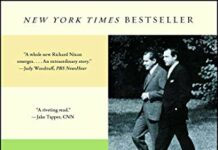
Ebook Info
- Published: 2009
- Number of pages: 512 pages
- Format: PDF
- File Size: 3.01 MB
- Authors: Bob Woodward
Description
Bob Woodward once again pulls back the curtain on Washington to reveal the inner workings of a government at war in his fourth book on President George W. Bush.The War Within provides an exhaustive account of the struggles of General David Petraeus, who takes over in Iraq during one of the bleakest and most violent periods of the war. It reveals how breakthroughs in military operations and surveillance account for much of the progress as violence in Iraq plummeted in the middle of 2007. Woodward interviewed key players, obtained dozens of never-before-published documents, and had nearly three hours of exclusive interviews with President Bush. The result is a stunning, firsthand history of the years from mid-2006, when the White House realizes the Iraq strategy is not working, through the decision to surge another 30,000 U.S. troops in 2007, and into mid-2008, when the war becomes a fault line in the presidential election. The War Within addresses head-on questions of leadership, not just in war but in how we are governed and the dangers of unwarranted secrecy.
User’s Reviews
Editorial Reviews: Review “[B]rilliantly reported…” — Timothy Rutten, Los Angeles Times”A better first draft of history might be difficult to find.” — Gilbert Cruz, Time”More than mere anecdotal detail, this is the stuff of history… The fine detail is wonderfully illuminating, and cumulatively these books may be the best record we will ever get of the events they cover… They stand as the fullest story yet of the Bush presidency and of the war that is likely to be its most important legacy.” — Jill Abramson, The New York Times Book Review”…recalls David Halberstam’s iconic The Best and the Brightest…The War Within’s controversial revelations are contentions and numerous…But, mainly, it is a study of what happens when men and women, charged with leading the country in wartime or with counseling those who lead, do not tell each other what they really think.” — Josiah Bunting, III, The Washington Post”An extraordinary window into policy making.” — The Kansas City Star”The In Cold Blood of national security journalism.” — The Nation”If you want to know about the Iraq War, Bob Woodward is the guy.” — Bill O’Reilly”Bob Woodward is the latest to remind us that it is presidents, not their understudies, who shape the destiny of nations.” — Fouad Ajami, The Wall Street Journal About the Author Bob Woodward is an associate editor atThe WashingtonPost, where he has worked for thirty-seven years. He has sharedin two Pulitzer Prizes, first for the The Washington Post’s cov- erage of the Watergate scandal, and later for coverage of the 9/11 terrorist attacks. He has authored or coauthored eleven #1 national nonfiction bestsellers, including three on the current administration—Bush at War (2002), Plan of Attack (2004), and State of Denial (2006). He lives in Washington, D.C.
Reviews from Amazon users which were colected at the time this book was published on the website:
⭐”The War Within” is Woodward’s 15th book, and his fourth about the Bush administration. I received an advance copy.Woodward interviewed President George W. Bush twice, and he interviewed Vice President Dick Cheney, Secretary of State Condoleezza Rice, and Defense Secretary Robert M. Gates.I’ve noticed that in all of Woodward’s books about Bush, he seemed to be full of praise for Bush when Bush was flying high in the ratings. But when Bush was low in approval ratings, so was Woodward’s opinion. So I’ve got to question if Woodward has gone from the great investigative reporter he once was to an establishment me-too type.After reading this, one can only be grateful that the Bush presidency is close to an end. Trouble is, it leaves a mess behind.According to Woodward, the surge has worked but Bush failed to lead and made numerous blunders that were very costly.The White House’s National Security Adviser, Stephen Hadley, put out a statement Friday, Sept. 5, prior to release of the book, disputing some of the assertions made by Woodward.Woodward says that Bush has not told the American public the truth about Iraq and the war in general. But I found it of interest that Bush allowed Woodward to interview him and give him access. He said that Bush seems to have aged considerably during his long tenure in office — he has a “paunch” and slumps when sitting.Of Bush Woodward says, “He did not seek sacrifice from most of the country when he had the chance. He did not even mobilize his own party. Republicans often voiced as much suspicion and distrust as Democrats. The president was rarely the voice of realism on the Iraq war.”Woodward does, however, admit the success of Bush’s surge of additional troops into Iraq in 2007.”Violence was down so much in a few places that some U.S. soldiers were not receiving combat action badges because there was no fighting in their area,” he wrote.Woodward says in the book that deputy national security adviser Meghan O’Sullivan sent President Bush a daily top secret report that cataloged the escalating bloodshed and chaos in Iraq. He quotes one memo as follows:”Violence has acquired a momentum of its own and is now self-sustaining.” She wrote this on July 20.Woodward says, “Her dire evaluation contradicted the upbeat assurances that President Bush was hearing from Gen. George W. Casey Jr., the U.S. commander in Iraq. Casey and Defense Secretary Donald H. Rumsfeld were pushing to draw down American forces and speed the transfer of responsibility to the Iraqis. Despite months of skyrocketing violence, Casey insisted that within a year, Iraq would be mostly stable, with the bulk of American combat troops headed home. “”Publicly, the president claimed the United States was winning the war, and he expressed unwavering faith in Casey, saying, ‘It’s his judgment that I rely upon.’ But Woodward continues, “privately, he was losing confidence in the drawdown strategy. He questioned O’Sullivan that summer with increasing urgency: “What are you hearing from people in Baghdad? What are people’s daily lives like?”The book reads like a Tom Clancy novel and is full of almost surreal events. But the unusual thing I noticed was that Bush seemed to admit the truth in the book. He acknowledged his frustration and anxiety and that things didn’t happen as he had planned. The war was not working and more people were dying than he’d imagined.Bush said his goals were a free society that could defend, sustain and govern itself while becoming a reliable ally in the global war on terrorism. But he was not sure that could be obtained. “It seems Iraq is incapable of achieving that,” Woodward quotes in the book.Woodward rightly reminds us that Barack Obama opposed the surge and John McCain was “advocating more troops for years.”Woodward says McCain showed considerable anger with the Bush White House by saying, “Everything is f—ing spin.”Gen. George Casey, former U.S. commander in Iraq, said “that President Bush does not understand the war.”Woodward says of Bush, “He had not rooted out terror wherever it existed.” He adds, “He had not achieved world peace. He had not attained victory in his two wars.”Woodward takes us into the heart of the White House and Pentagon. He apparently had tremendous sources who were actually in the meetings and conversations. The book reads like a novel by Tom Clancy.Since the book is based on literally hundreds of interviews with people in the know, it is full of conversations of actual events. It gives us an excellent view of the way Bush thinks and relates to those around him.We also see how he formed lies about the way — lies that he thought would sell the war and make it more palatable to the American public.While the book goes back and pulls information from his previous books on Bush, this book is an excellent read with some new and astonishing revelations.Highly recommended.- Susanna K. Hutcheson
⭐This is Woodward’s fourth book on the Bush Presidency at war. It’s also, I thought, the best. As with all of Woodward’s books, the reader is left to wonder how exactly Woodward acquired all of his insider information. However, it is clear he had access to the biggest players involved in the Bush Administration’s efforts in Iraq. He obviously interviewed the most important people. Any criticisms from the pro-Bush crowd can be offered if those insiders feel so inclined. The White House itself issued a rebuttal of sorts, but still it seems that the bulk of Woodward’s reporting has gone unchallenged. That may well be because those who know inside stuff cannot talk about it, but that’s the way it goes in a democracy that treasures civil liberties and press freedoms. Whiners need not run for office (nor should anyone try to stop anyone else from whining). We can either not have the Woodward book, or we can have it with the understanding that there are likely certain inaccuracies. I’ll take the latter, hands down. Those who had their mitts in devising poorly thought-out plans will have their shot at offering other perspectives (see Feith, Bolten, etc.)This book covers the Bush Administration from early 2006 until about mid 2008. We see the President try to deal with the increasing problems that were evident in Iraq, problems that contradicted President Bush’s overly optimistic public statements. We also see the efforts of those in the Pentagon, State Department, and in Iraq as they tried to come up with a strategy to address the increasing violence. As we mostly now know, the “surge” and elements often incorrectly associated with that title have reduced the violence in Iraq. What we haven’t known about, and what we hope Woodward is accurate about, are the discussions, arguments, etc., that went into coming up with the surge. Fascinating stuff. People of all political persuasions can take comfort in knowing that the smartest people in the world of every ideology were hard at work on the problem and all were striving with good intentions. (Certainly, good intentions do not ensure good policy and may at times encourage foolhardy policies.)When all is said and done, Woodward offers his thoughts on President Bush’s war leadership, and Woodward makes a strong case for weak war leadership. Ultimately, Bush knew things weren’t going well and was lying to the American people when he claimed all was well. He should have trusted the American people at an earlier stage of the war. Perhaps the Washington clock would have had a longer run time. The President should have also been more honest with himself. Contrary to claims of the right, the media was more accurate about the state of Iraq than the President was, and it seems that the President willed himself to believe things that were simply untrue. Who paid the price for those huge mistakes? He did to a small degree: his place in history will likely be among the lower ranked of our presidents. At best, he can hope for below average. We invaded Iraq because we believed that Saddam was a threat to us, and we believed Saddam was a threat because we believed he had WMDs. We now know we were wrong, and “the Decider” bears the most blame for that mistake. It was his call, and he got it wrong. Perhaps worse is that the US plan for winning there was disgracefully off the mark in every regard. From the initial invasion until final implementation of the surge, the Bush team made mistake after mistake, and history has recorded those facts. But those who paid the ultimate price for those mistakes are our brave servicemen and women and lots of Iraqis.Personally, I don’t view George W. Bush as an evil man. His intentions were pure, but pure intentions… Also, though the US effort was in disarray in 2006, and although we know who is ultimately responsible for that tragic state of affairs, perhaps the best that can be said of President Bush is that he may have been the one man who could have made the surge the reality it needed to be because of his own mistakes. Time will tell, but the time that has passed so far is not flattering to President Bush, and Woodward writes about it in captivating detail.
⭐The book turned up in prompt time and in perfect condition.
⭐The recipient loved it
⭐Perfect
⭐This is the 4th book in Bob Woodward’s “Bush at War” series. He continues to prove himself as a first class reporter who, after meticulously researching his subject matter, sets out the facts, as best as he can honestly ascertain them, in a non-judgmental style, for his readers’ consideration. Unlike very many writers on such issues, he has no obviously personal point of view to promote. His work is clearly objective, and probably provides the best currently available history of America’s wars during the past eight years. I highly recommend them all to those interested in what is arguably the most critical dilemma which faces America, Iraq and by extension, us all, today. I believe that society should feel deeply indebted to the author for this profoundly illuminating and always interesting account. In my opinion it is never dull, repetitious or superfluous.”The War Within” deals in much detail with the post invasion problems encountered by the US in Iraq. There was never any doubt that stage one of the invasion would succeed militarily – how could it not? What was at issue was the non-existence of a plausible exit strategy. Many advisors in and around the Bush administration, including the Joint Chiefs, were against the invasion on the grounds that they could not see “a way out” post invasion. The then Secretary of State, Colin Powell, warned Bush 6 months prior to the invasion that it would lead to Bush becoming “the proud owner of 27 million people”. Powell and his deputy Richard Armitage referred to this as the Pottery Barn Rule: “You break it, you own it”.George W Bush, with the strong support of Vice President Cheney and of Secretary of Defense Rumsfeld, had been, even prior to the Twin Towers attack, determined to remove Saddam Hussein from power and was fully prepared to commit the US to physical invasion to achieve this end, given any reasonable pretext. There has been much discussion and speculation as to why Bush was so determined to do this. Many feel that his prime motivations included the securitization of Middle Eastern oil supplies / the establishment of a politically redefined Iraq under control of leaders friendly to US interests in such a strategically important geographical zone / the feeding of the industrial military complex / the need to demonstrate US power and determination to other nations temped to align themselves on the side of terrorists – etc. George W Bush has always claimed that his prime motivation was the export of democracy to an area under brutal totalitarian control. Perhaps he genuinely believed this. He feels that History will judge him. This book, and the other 3 books in this series, contributes much to our understanding of that history.The “War Within” referred to in the title of this 4th book can equally well apply, on the one hand, to the serious disagreements that arose within the U.S. administration, and within the military, as to the hows and whys of the Iraq invasion and the subsequent conduct of the liberation / occupation, and, on the other hand, to the intense factional disputes which grew and still persist amongst the Iraqi political and religious groupings which have rendered the resolution of this conflict so difficult, both for the U.S. administration and for Iraqi people. It deals in great detail with the “Surge”, which we heard so often referred to by John McCain and others, in last year’s Presidential campaign, when that highly complex issue was usually reduced to simplistic sound bites for the voting public’s consumption. That’s the way politics is spun worldwide. If we want to understand what is going on we need to get away from the spin-machine and find someone we can rely on to give us the best truth that is currently available.Bob Woodward writes in the notes to this book: “I realize that because this book provides the first in-depth examination of the deliberations that led to the troop surge in Iraq, it is much closer to the first draft of history than to the last. I have tried as always to obtain the best obtainable version of the truth”.In my view he has succeeded admirably.
⭐Going on holiday, then take this with you. Great insight to what went on and very well written to boot.A great history lesson that is entertaining as well.
Keywords
Free Download The War Within: A Secret White House History 2006-2008 in PDF format
The War Within: A Secret White House History 2006-2008 PDF Free Download
Download The War Within: A Secret White House History 2006-2008 2009 PDF Free
The War Within: A Secret White House History 2006-2008 2009 PDF Free Download
Download The War Within: A Secret White House History 2006-2008 PDF
Free Download Ebook The War Within: A Secret White House History 2006-2008





